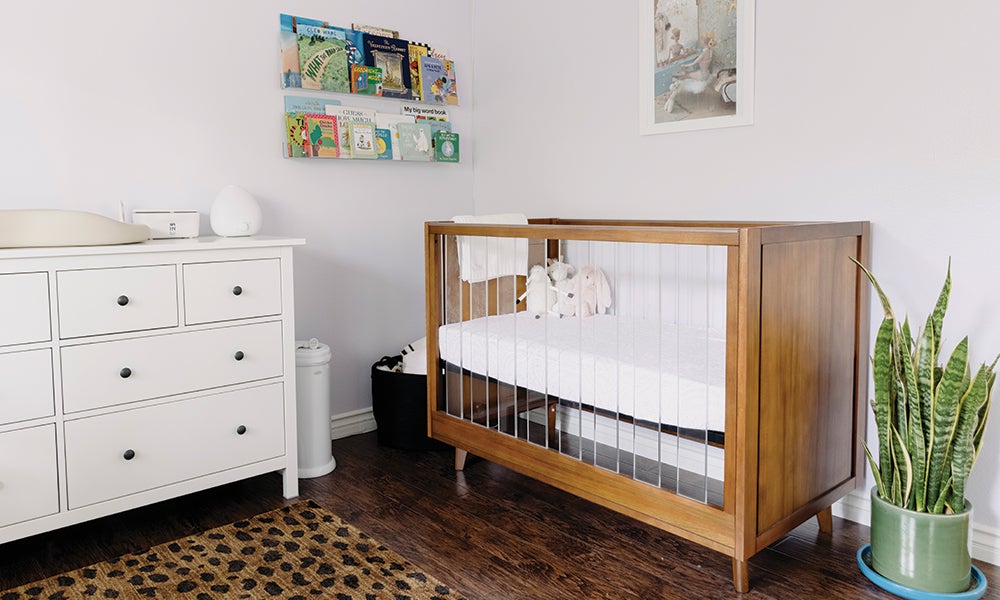When it comes to your baby’s first few months of life, things are hectic (to say the very least). At the same time, things can move and develop at a rapid pace — including when it comes to your baby’s sleep hygiene.
Before you know it, it’s time for your baby to move from a bassinet to a crib. But when is the right time, and how can you make this transition successful?
For answers, we spoke to Jenni June, CLC, a certified baby and toddler sleep consultant, lactation counselor, and mom of four.
Here are Jenni’s expert tips, tricks, and must-knows from her experience as both a professional pediatric sleep consultant and mother.
When is it time to transition from a bassinet to a crib?
Jenni says the ideal time to transition from a bassinet to a crib is at the 4-month mark.“
This is when they start rolling over and movement becomes a process of self-settling to sleep or going back to sleep,” she begins. “It is also when babies start creating strong associations with their sleep environment.”
What’s the gold standard for the baby’s crib and bedroom environment?
For starters, Jenni says that the crib and sleep environment should meet all the recommendations for safe sleep as outlined by the American Academy of Pediatrics (AAP).Among other things, the AAP outlines:
- the baby’s ideal sleeping position
- how firm the baby mattress should be
- what should and shouldn’t be in the crib
- notes on room sharing
- Of course, the baby’s sleeping environment should also be free from loud noises, excess light, and other such disturbances.
On top of that, Jenni notes the terrific developments in technology when it comes to baby monitors. With them, “many parents feel they are better able to monitor their baby for safety while also providing a sleep environment that is conducive to undisrupted sleep — especially during the day — by moving the baby to their crib in their own nursery,” she explains.
What else should parents know about easing their baby into crib sleeping?
Here are a few final tips and bits of wisdom when it comes to transitioning from a bassinet to a crib.
Erratic sleep schedules are natural
Jenni says that during your baby’s first 16 weeks of life, “their sleep is designed to be light, active, sporadic, and disorganized.”
But why are these sporadic sleep patterns normal?
“Babies aren’t born with a circadian rhythm; they don't have the ability to produce melatonin on a timed basis,” she explains.
Light sleeping during this period is a byproduct of a survival instinct of sorts. As Jenni continues, this sleep pattern is built-in so your baby “can easily resuscitate should their fragile physical vitals fall below normal.”
Read: If your baby has trouble sleeping, that surely doesn’t mean that you’re to blame!
Weed out the noise
Next, she advises against going down the Google/message board rabbit hole. “There’s a poor, unsafe, and loud overload of conflicting internet ‘advice’ that instills fear into new parents,” she starts.
Reading too much into misinformation or unfounded modalities can hinder a parent’s “ability to trust their own parenting instincts that help us fully attune to and follow the baby's unique rhythms and needs,” she continues. This rings true when it comes to your baby’s sleep and otherwise.
Further, at this stage of your baby’s life, she advises against rigid protocols for sleep schedules and sleep training.
Trust your instincts + adjust accordingly
Finally, Jenni urges new parents and caretakers to trust their instincts and take it easy.
Ending on a positive note, she wants to let parents know that even if you face struggles transitioning from a bassinet to a crib, the experience should only be temporary.
“The good news is that you can't create any permanent bad sleep habits [in the baby’s ‘fourth trimester’],” she concludes. “It all changes once the baby is biologically capable of getting deeper, consolidated, more organized and restorative sleep at 4 months of age. This is when they do need you to evolve your care routines, sleep environment, and parenting responses to meet and match their evolving, developing needs for sleep.”
For more tips on pediatric sleep and other bits of baby wisdom, follow Jenni on Instagram.


